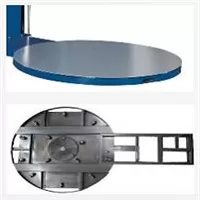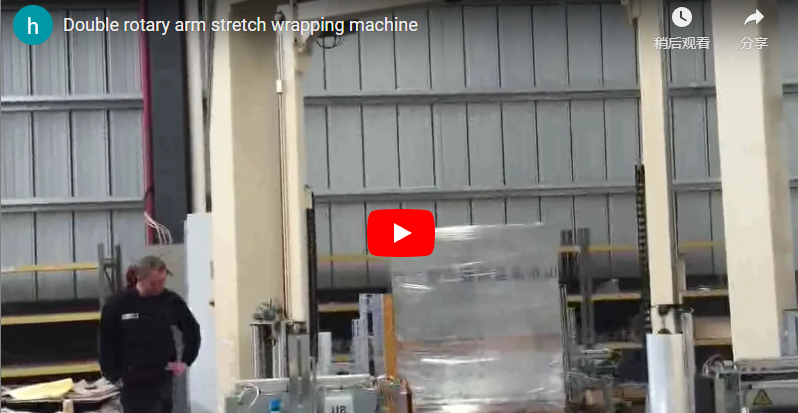Mastering Pallet Security: A Deep Dive into the A200 Stretch Wrapping Machine Process
In today's fast-paced manufacturing and logistics environments, ensuring palletized goods arrive safely and securely is paramount. Load shifting, product damage, and contamination during transit or storage can lead to significant costs and customer dissatisfaction. This is where automated stretch wrapping technology, exemplified by machines like the A200, becomes indispensable. This article delves into the operational process of the A200 stretch wrapping machine, offering technical insights and practical perspectives to help you understand its value and optimize its use.
A robust stretch wrapping machine is more than just equipment; it's a critical component in maintaining product integrity and streamlining the end-of-line packaging process. Let's break down how the A200 typically achieves this.
1. Understanding the A200 Stretch Wrapper: Core Functionality
The A200 appears to be a turntable-style automatic stretch wrapping machine. This design is common in many industries due to its efficiency and reliability. The core principle involves placing a pallet load onto a rotating turntable while a film delivery system vertically dispenses stretch film, securely encasing the load. Automating this process significantly enhances throughput compared to manual or semi-automatic methods.
2. Key Technical Specifications (Typical for A200 Class Machines)
While exact specifications can vary, machines in the A200's category often feature parameters like these:
- Turntable Diameter: Typically around 1500mm - 1800mm (accommodates standard pallet sizes).
- Maximum Load Weight: Often ranges from 1500kg to 2500kg.
- Maximum Wrapping Height: Commonly 2000mm - 2400mm, sometimes extendable.
- Turntable Speed: Adjustable, often up to 12-15 RPM.
- Film Delivery System: Powered pre-stretch unit (e.g., 200%-300%) is crucial for film economy and load containment.
- Control System: PLC (Programmable Logic Controller) based, often with a user-friendly HMI (Human Machine Interface) for setting parameters like top/bottom wraps, rotation speed, and film tension.
- Power Requirements: Specific voltage and phase (e.g., 380V/3Ph/50Hz or customer specific).
- Safety Features: Emergency stops, safety fencing interlocks (optional), photo-eye sensors for height detection.
Note: Always refer to the manufacturer's official documentation for precise A200 specifications.

3. The Pallet Wrapping Process: A Step-by-Step Breakdown with the A200
Observing the A200 in action reveals a carefully orchestrated sequence designed for efficiency and consistency:
3.1. Pallet Loading and Positioning
The process begins when a loaded pallet (transported via forklift, pallet jack, or conveyor) is placed centrally onto the machine's turntable. Proper positioning is key for a balanced wrap and stable operation. Sensors may confirm the pallet's presence before initiating the cycle.
3.2. Film Attachment and Initiation
Once the pallet is detected and the start signal is given (often via remote control or control panel), the automatic sequence commences. A film clamp system securely grips the leading edge of the stretch film. The turntable begins to rotate, pulling the film from the roll and initiating the wrap around the base of the pallet load.
3.3. The Automated Wrapping Cycle
The film carriage, holding the stretch film roll and pre-stretch mechanism, travels vertically up the mast as the turntable rotates. The PLC controls the ascent/descent speed and turntable rotation speed based on pre-set parameters. Key settings include:
- Bottom Wraps: Number of wraps applied at the base for stability.
- Top Wraps: Number of wraps applied at the top of the load.
- Pre-stretch Ratio: The percentage the film is elongated before application (critical for film savings and holding force).
- Film Tension/Force-to-Load: Controls how tightly the film is applied.
- Overlap: How much each successive film layer overlaps the previous one.
Photo-eye sensors detect the top of the load, ensuring the wrap covers the entire height accurately, even with variable load heights.
3.4. Film Cutting and Securing
Upon completion of the programmed wrap cycle (including the specified top wraps), the film carriage typically descends slightly. An automated system (often a hot wire or mechanical cutter) cuts the film. Simultaneously, a wipe or brush mechanism presses the film tail against the load, ensuring it adheres securely and doesn't unravel.
3.5. Pallet Discharge
With the cycle complete, the turntable stops, usually in the original home position. The fully wrapped pallet is now ready for removal by forklift or movement onto an exit conveyor system. The machine is immediately ready for the next pallet.
4. Why Choose an Automatic Stretch Wrapper like the A200? The ROI Perspective
From a fabricator's or manufacturer's viewpoint, investing in an automatic wrapper like the A200 offers tangible benefits:
- Increased Throughput: Wraps pallets significantly faster and more consistently than manual methods.
- Improved Load Integrity: Consistent wrap patterns and tension control dramatically reduce product damage during shipping. Proper load containment is crucial for stability.
- Material Savings: Powered pre-stretch systems can stretch film by 200-300% or more, significantly reducing film consumption and cost per pallet compared to manual wrapping.
- Labor Optimization: Frees up personnel previously assigned to manual wrapping for more value-added tasks.
- Enhanced Safety: Reduces manual labor involving walking around loads with heavy film rolls, minimizing risks of strains or trips.
5. Operator Insights & Maintenance Tips
From experience on the floor, getting the most out of your A200 involves:
- Proper Training: Ensure operators understand the HMI, parameter settings (especially film tension and pre-stretch), and safety procedures. Incorrect settings can lead to poor load containment or film breaks.
- Film Quality Matters: Use high-quality stretch film designed for machine application and compatible with the pre-stretch capabilities. Cheap film can break easily or not stretch properly.
- Routine Checks: Regularly inspect the film clamp, cutter, and wipe-down mechanisms. Keep photo-eye sensors clean for accurate height detection.
- Listen to the Machine: Unusual noises from the turntable drive, mast assembly, or pre-stretch rollers often indicate a need for maintenance (e.g., lubrication, bearing check).
- Preventative Maintenance: Follow the manufacturer's recommended PM schedule for lubrication, chain tensioning, and wear part inspection.
6. Beyond the Basics: Optimizing Your Stretch Wrapping
To truly maximize efficiency and effectiveness:
- Dial-in Pre-Stretch: Don't just set it and forget it. Test different pre-stretch levels to find the optimal balance between film savings and load holding force for your specific products.
- Customize Wrap Patterns: Use the PLC controls to tailor wrap patterns (e.g., reinforcing wraps at specific points, different ascent/descent speeds) for non-standard or particularly unstable loads.
- Consider Film Types: Explore different film formulations (e.g., stiffer films for heavy loads, puncture-resistant films for sharp edges) to best match your application.

Conclusion: A Reliable Workhorse for Pallet Security
The A200 stretch wrapping machine, as demonstrated in the video, represents a practical and efficient solution for automating pallet packaging. By understanding its operational steps, key parameters, and optimization potential, businesses can leverage this technology to enhance product protection, reduce packaging costs, and improve overall operational efficiency. It's a foundational piece of equipment for any operation serious about getting its products to their destination intact.
For more information on stretch wrapping solutions:
https://www.fhopepack.com/Stretch_wrapping_machine.html
Contact us for inquiries:
info@fhopepack.com






